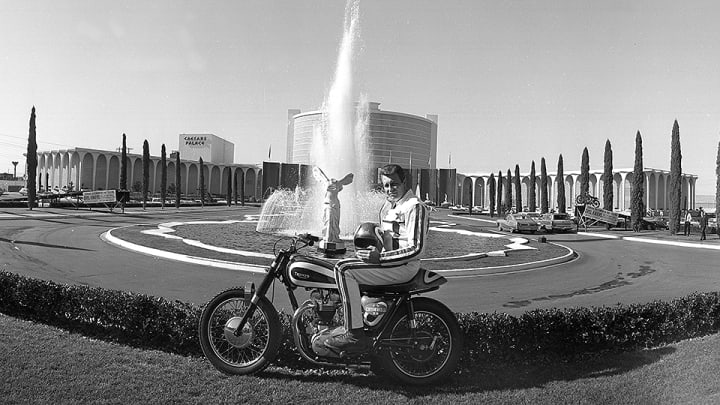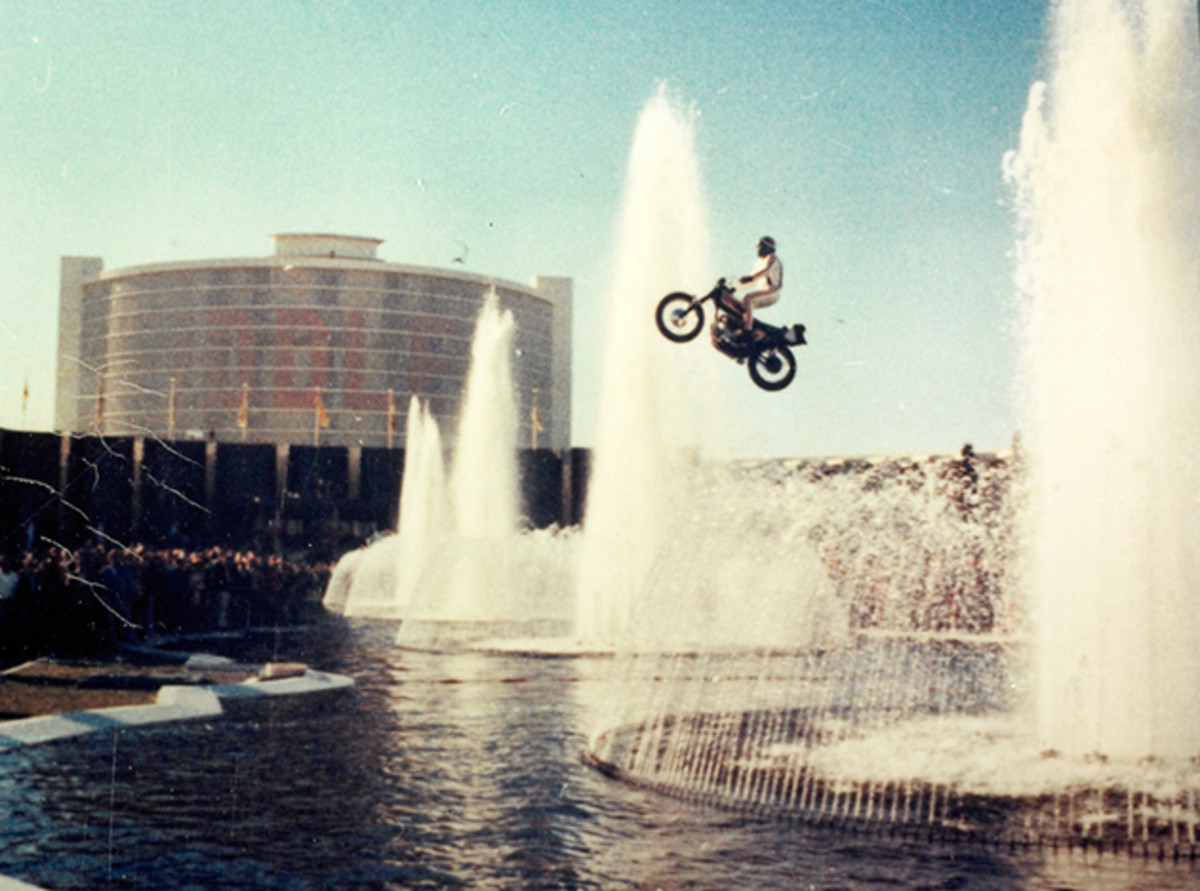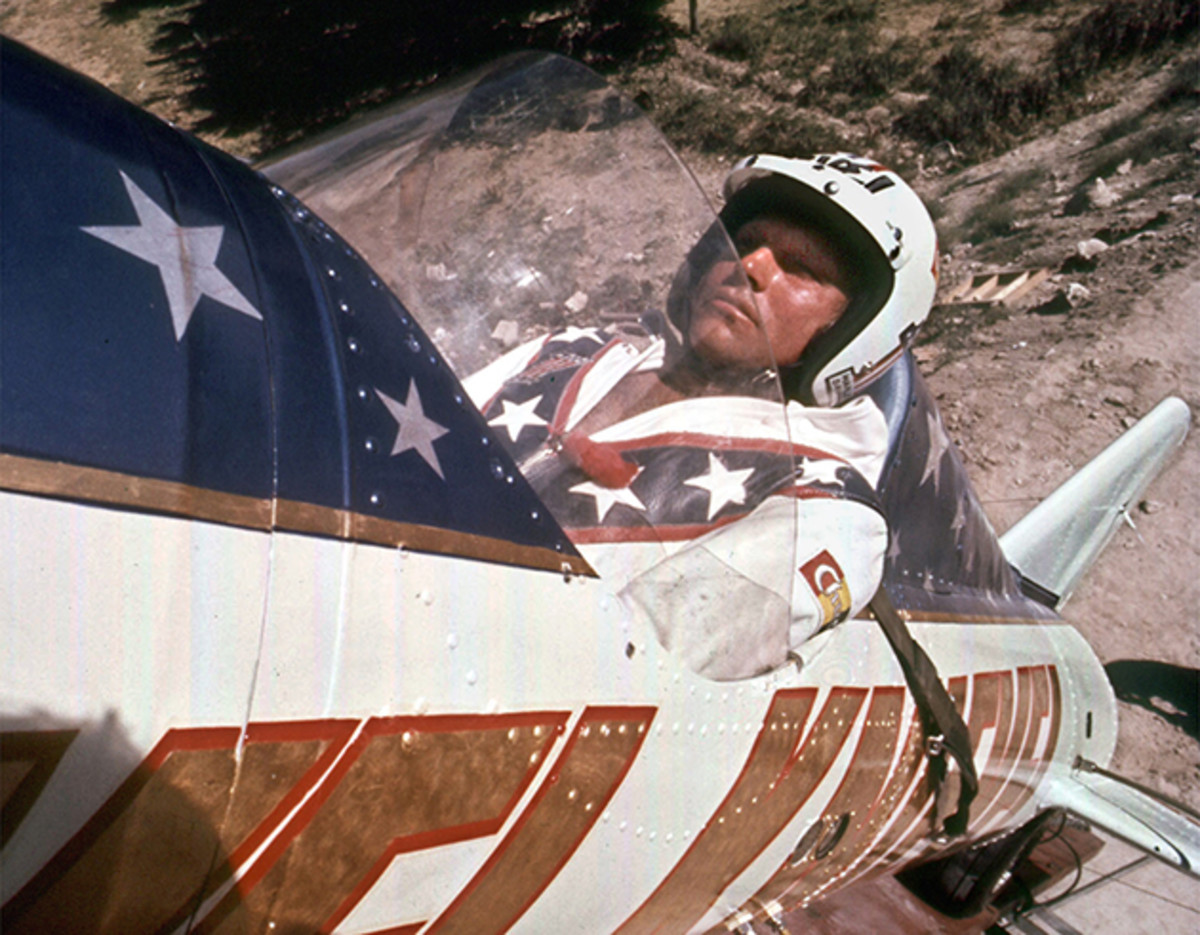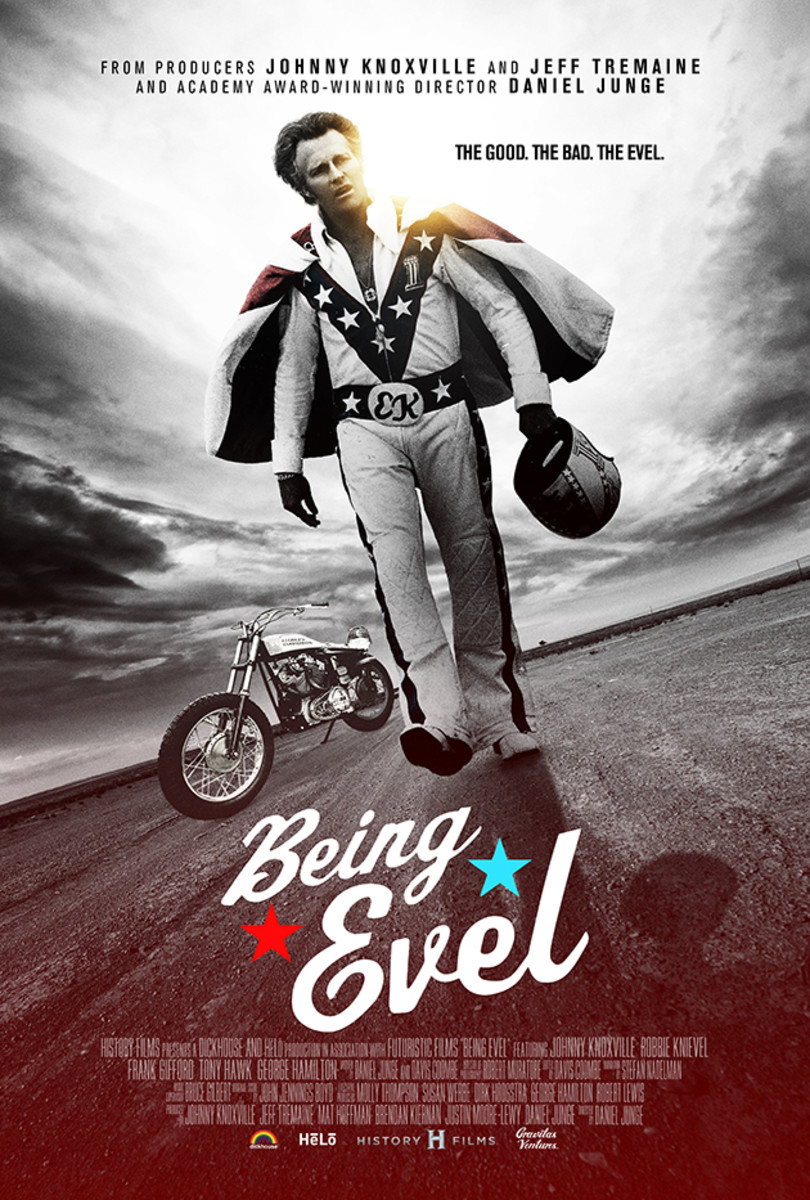New Evel Knievel documentary Being Evel gets to the heart of the daredevil

All you need to know about how complicated a character Evel Knievel was can be drawn from the following comments. Asked what Knievel would think about the new Being Evel documentary, which opens nationwide today (Friday, Aug. 21), BMX stunt prodigy Mat Hoffman chuckles.
“He’d say, ‘Oh, man, right on!’” says Hoffman, a longtime friend and former business partner of Knievel's.
But co-producer Johnny Knoxville, of Jackass fame, replies to the same question: “He’d probably be pretty pissed. He had a public persona, and that’s what he wanted out there. He wasn’t a guy who would tolerate anything else. I don’t know what to do about that.”
“He had a really extraordinary life,” says Knoxville. “You'll see how intelligent the man was, and the P.T. Barnum-level showman he was. You’ll see his public side, and you’ll see the truth of his private side. Some of those things are disappointing, and tough for me to reconcile, honestly, because I’m such a fan. But we wanted to be honest about it, about what kind of husband he was, how he handled himself when no cameras were around.
"Luckily, we interviewed a lot of his friends, and people who worked with him back then, and they were very honest about things. So I think it’s the exact documentary that we wanted to make.”
What Knoxville, co-producer Jeff Tremaine, and Oscar-winning director and screenwriter Daniel Junge did was create an unvarnished documentary that commemorates one of the quintessential showman and athletes of his generation, while stripping away the veneer that Knievel—born Robert Craig Knievel on Oct. 17, 1938—had carefully crafted over his swashbuckling 30-year career. Knievel died in 2007, at 69, of heart failure.
Mountain biker Brandon Semenuk’s unReal video: Long shot pays off
“This was right in our wheelhouse,” says Knoxville, 44, who still has an Ideal Evel Knievel action toy from his childhood. “This is someone that we grew up idolizing, so we jumped at the chance. We were like, ‘Hell ya. We can really tell Evel’s story in a way it’s never been told.’
“We thought we had a point of view and a way into that, because we wanted to tell a complete story of Evel’s life. We wanted to celebrate what he had done, and what he inspired, and also be honest about the man he was.”
The documentary lists a Who's Who of modern-day thrill-seekers, many of who were motivated by Knievel’s exploits decades earlier. People like Hoffman, Nitro Circus star Travis Pastrana, and skateboarder Tony Hawk.
“He’s sort of the grandfather, or forefather, of everybody [in the action-sports arena],” says Hoffman, 43. “It’s just the attitude of letting your imagination define your life. Dreaming the impossible, and making it happen. That’s the spirit, the kindred spirit, we have. Our sports are all about progressions, and dreaming of things that have never been done.”
Knoxville said extreme sports—from Nitro Circus to ESPN’s X-Games—owe a debt of gratitude to Knievel. A native of Butte, Mont., and later inspired by the Joie Chitwood Auto Daredevil Show, Knievel became a pioneer of the action-sports genre.

“I just remember him being such a large figure in my childhood,” Knoxville says. “There was no one bigger than EvelKnievel. There were some people equal to EvelKnievel, like Muhammad Ali and Elvis, in my mind. [Knievel] was one of the biggest figures of the 20th century, definitely one of the largest personalities.
“He's still part of my life. I don’t think there would be a Jackass without Evel, and I don’t think there would be an X-Games without Evel. If there was an X-Games, it wouldn't look like it does now. They’re top athletes, but there’s a whole daredevil aspect to it, and that came from Evel.”
To provide a more complete portrait, the documentary also features a number of Knievel family members and former co-workers and friends, including promoter Shelly Saltman and celebrities such as George Hamilton, the late Frank Gifford, and Geraldo Rivera.
Mildon vs. Foster: The toll of landing the first-ever quad flip on a BMX bike
“We just wanted to show a full picture of just how complex this man was," said Hoffman. "The family really doesn't want to show the dark side, either, but I've been with the family, and been friends with Evel for a long time, and they had confidence that we would tell the real story and tell it right and keep it balanced to justify what a legend he really is.
"We learned a lot about Evel, more than anybody’s ever told, and more than anybody has ever exposed,” Knoxville says. “And I think that’s a big difference.”
Hoffman saw Kneivel’s guarded side first hand, when the two first met. They eventually became longtime friends, and worked together on a Knievel line of bicycles. That led to a classic episode revealing ’Knievels compulsive nature.
“When we decided to do bikes, I agreed to bring a cashier’s check for $25,000 to Caesars Palace, and we’ll sign a contract,” says Hoffman. “I thought, ‘Well, that's a lot of money, and this is kind of crazy, but it’s Evel Knievel.’ So I said sure.
“When I got there, I give him the check for 25 grand, he gave it to his wife, Krystal, she put it on black, and it was gone.” Hoffman manages a laugh. “I just kind of got choked up. Then I thought, this is Evel Freakin’ Knievel; of course that’s going to happen. So I just swallowed that memory and tried to never think about it again.”

Of course, Being Evel offers numerous highlight-reel moments of Knievel, resplendent in his stars-and-stripes trimmed white leathers, including the career-defining crash at Caesars Palace in Las Vegas in 1967, the failed 1975 jump before 90,000 at Wembley Stadium in London, his last big jump later that year at King’s Island in Ohio, where he successfully cleared 14 Greyhound buses, and the bizarre, botched spectacle that was the Snake River Canyon jump in Idaho.
“I love Snake River,” says Hoffman. “It was a classic example of Evel just going for it, and thinking about it later. That was pretty amazing.”
After the Caesars crash, which wasn’t shown live, Knievel became must-see TV (he was featured in seven of the 10 highest-rated episodes of ABC's Wide World of Sports). Knievel drove that agenda with the same entrepreneurial knack that persuaded the Czechoslovakian national hockey team to visit Montana to play an exhibition against his semi-pro Butte City Bombers in 1960, in the midst of the Cold War.
Barbarian Days: William Finnegan's surfing memoir is a glorious ride
“He inspired a whole new way of thinking,” says Knoxville. “He really blew open the door for a whole new dimension of sports. And showmanship. You can’t talk about what he did for sports without talking about his showmanship and what an amazing self-promoter he was.”
But the disastrous moments took their toll. Knievel’s litany of injuries includes more than 400 fractures (433, to be exact), which landed him in the Guinness Book of World Records. It also landed him in the hospital countless times.
“We show him going through the intense pain and the surgeries,” says Hoffman. “Back in that era it was a whole different game. Then trying to get back up, and keeping your head clear enough to be able to perform the impossible. And doing that, over and over and over. And all these dreams of just going bigger, all that just snowballs. It's kind of surprising that he survived.”
The lack of modern medical care wasn’t the only impediment to Knievel’s career trajectory. The motorcycles he rode, and jumped, where a far cry from today’s stunt-specific rigs (his iconic 300-pound Harley-Davidson XR-750 is on display in the Smithsonian Institute).
"He was jumping on bikes not made for jumping, because no one had ever jumped a bike before," said Knoxville. "They weighed twice as much as today's bikes, and didn't have any suspension. And not enough power. He was jumping dump trucks, basically."

That fact simply fed the legend.
"He kind of created this character, Evel Knievel, who was invincible,” says Hoffman. “And then he became Evel Knievel. It was almost hard for him to deal with himself as Evel Knievel. But that’s where the hype and the fame had brought him to. He sort of became the super hero that we all saw him as.”
But the character, and the man, were often at odds, says Knoxville.
“He really painted himself into a corner,” he says. “He even said, himself, ‘I created Evel Knievel, and he sort of got away from me.’ It’s a hell of a thing to live up to.
“Evel said, ‘People will constantly want more and more, and I have to give more and more of myself each time.’ That’s a hell of thing to look at day in and day out. It’s like saying, ‘I’m going to be a gunfighter, and that’s going to be my life. That’s how I’m going to make my money.’ And that’s what Evel was. He was a gunfighter.”
Unlike far too many gunfighters who wound up on the wrong end of the draw, however, Knievel seemed to have nine lives. That, says Hoffman, may be the entertainer’s greatest achievement.
“Evel never stayed down,” says Hoffman. “He always got back up. He always went for it. He learned from failure, and just kept going until he succeeded. And I think that’s a good inspiration for life.”
